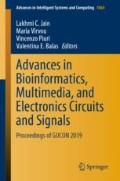Abstract
Diabetes is a disease with which many people are affected, and diagnosing diabetes is becoming an important task. Machine learning algorithms are widely used for detection and classification process. In this work, we have used five classifiers to diagnose disease. The dataset, Pima Indian diabetes database, used to validate our work is taken from an online repository. We evaluated different machine learning algorithms for their accuracy. The classification accuracy was comparable to the state-of-the-art ranging from 70.12 to 79.22%. In this work, we suggested that the Naïve Bayes algorithm is an optimal algorithm, which is good in terms of accuracy as well as running time complexity.
Access this chapter
Tax calculation will be finalised at checkout
Purchases are for personal use only
References
E. Dogantekin, A. Dogantekin, D. Avci, L. Avci, An intelligent diagnosis system for diabetes on linear discriminant analysis and adaptive network based fuzzy inference system: LDA-ANFIS. Digit. Signal Process. (2010)
K. Polat, S. Güneş, A. Arslan, A cascade learning system for classification of diabetes disease: generalized discriminant analysis and least square support vector machine. Expert Syst. Appl. (2008)
S.N. Ghazavi, T.W. Liao, Medical data mining by fuzzy modeling with selected features. Artif. Intell. Med. (2008)
M.F. Ganji, M.S. Abadeh, A fuzzy classification system based on ant colony optimization for diabetes disease diagnosis. Expert Syst. Appl. (2011)
K. Kayaer, T. Yildirim, Medical diagnosis on pima indian diabetes using general regression neural networks, in International Conference on Artificial Neural Networks and Neural Information Processing (2003)
O. Erkaymaz, M. Ozer, M. Perc, Performance of small-world feedforward neural networks for the diagnosis of diabetes Appl. Math. Comput. (2017)
I. Fakhruzi, An artificial neural network with bagging to address imbalance datasets on clinical prediction, in 2018 International Conference on Information and Communications Technology, ICOIACT 2018 (2018)
D. Choubey, S. Paul, S. Kumar, S. Kumar, Classification of Pima indian diabetes dataset using naive bayes with genetic algorithm as an attribute selection. Commun. Comput. Syst. (2016)
S. Wei, X. Zhao, C. Miao, A comprehensive exploration to the machine learning techniques for diabetes identification, in 2018 IEEE 4th World Forum on Internet of Things (WF-IoT), (2018), pp. 291–295
S.A. Saji, K. Balachandran, Performance analysis of training algorithms of multilayer perceptrons in diabetes prediction, in Conference Proceeding—2015 International Conference on Advances in Computer Engineering and Applications, ICACEA 2015 (2015), pp. 201–206
S.K. Mohapatra, J.K. Swain, M.N. Mohanty, Detection of diabetes using multilayer perceptron, in International Conference on Intelligent Computing and Applications (2019), pp. 109–116
D.K. Choubey, S. Paul, K. Bala, M. Kumar, U.P. Singh, Implementation of a hybrid classification method for diabetes, in Intelligent Innovations in Multimedia Data Engineering and Management. IGI Global (2019), pp. 201–240
J.S. Tiruan, Artificial neural network. Neuron (2011)
L. Rokach, O. Maimon, Decision tree, in Data Mining Knowledge Discovery Handbook (2005), pp. 165–192
University of California, L. Breiman, Random forest. Mach. Learn. 45(5), 1–35 (1999)
C. Cortes, V. Vapnik, Support vector machine. Mach. Learn. (1995)
Naive Bayes classifier The naive Bayes probabilistic model
Author information
Authors and Affiliations
Corresponding author
Editor information
Editors and Affiliations
Rights and permissions
Copyright information
© 2020 Springer Nature Singapore Pte Ltd.
About this paper
Cite this paper
Kaur, P., Kaur, R. (2020). Comparative Analysis of Classification Techniques for Diagnosis of Diabetes. In: Jain, L., Virvou, M., Piuri, V., Balas, V. (eds) Advances in Bioinformatics, Multimedia, and Electronics Circuits and Signals. Advances in Intelligent Systems and Computing, vol 1064. Springer, Singapore. https://doi.org/10.1007/978-981-15-0339-9_17
Download citation
DOI: https://doi.org/10.1007/978-981-15-0339-9_17
Published:
Publisher Name: Springer, Singapore
Print ISBN: 978-981-15-0338-2
Online ISBN: 978-981-15-0339-9
eBook Packages: EngineeringEngineering (R0)

